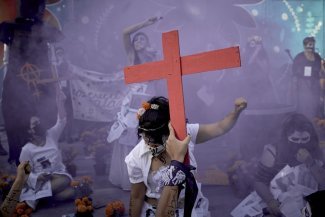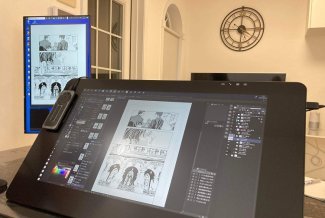On 16 September 2017 in Lynchburg, Virginia, a memorial plaque was dedicated to Ota Benga, a man brought to the United States from what is now the Democratic Republic of Congo in 1904 and exhibited in the Bronx Zoo.
Two signs bookend the tragic American sojourn of an immigrant from King Leopold’s Congo. The first was placed outside the monkey house at the Bronx Zoo in New York City on an autumn day in 1906:
“The African Pygmy, Ota Benga. Age, 23 years. Height, 4 feet 11 inches. Weight 103 pounds. Brought from the Kasai River, Congo Free State, South Central Africa, By Dr. Samuel P. Verner. Exhibited each afternoon during September.”
Verner’s lies about rescuing Benga from cannibals or that Benga himself was a savage in need of civilising satisfied his own ego. Such untruths and omissions of official history often reveal America’s unwillingness to confront racism and its costs.
The second sign seeks to right the record. Weeks after plans to topple monuments to the South’s Civil War heroes were used as a rallying point for violent white supremacists, people of all racial backgrounds elsewhere in Virginia erected a memorial to Benga in the town where he took his own life. The Benga unveiling ceremony was small, his memorial plaque simple compared to the imposing Civil War statues found across the United States. But the moment was significant.
The memorial sign in Lynchburg reads: “Mbye Otabenga, later known as Ota Benga, was born in what is now the Democratic Republic of Congo. In 1904 the Rev. Samuel P. Verner, adventurer and former Presbyterian missionary, brought Benga and eight other Congolese purported to be ‘Pygmies’ to be displayed at the St. Louis World’s Fair. Two years later the Bronx Zoo in New York exhibited Benga in its ‘Monkey House’ alongside an orangutan.
“Outraged African-American ministers secured his release from the zoo and placed him in an orphanage in Brooklyn. In 1910 Benga was brought to Lynchburg to attend the Virginia Theological Seminary and College. Despondent over his inability to return to Africa, he committed suicide in 1916.”
On a quest to remember
Author and journalist Pamela Newkirk, who helped draft the Lynchburg marker, wrote a 2015 book, Spectacle: The Astonishing Life of Ota Benga. In it, Newkirk noted that while Benga was being exhibited in New York, the remains of Sara Baartman – a Khoikhoi woman from modern-day South Africa who was exhibited in London and Paris between 1810 and 1815 – were on display at the Paris Musee de l’Homme. The attitudes that made it possible for human beings to be exoticised by Westerners who saw themselves as superior were behind “human zoos” in places like Hamburg, Milan and Brussels in the 1800s and early 1900s.
Benga was part of an ambitious ethnographic show at the St. Louis fair that included fellow Congolese as well as Ainu from Japan, Patagonians, Filipinos and even the defeated Apache leader Geronimo. At least in St. Louis Benga was exhibited amongst other men and women. By placing him with an orangutan in New York, the Bronx Zoo was questioning Benga’s very humanity.
Newkirk, a New York University professor, went to Lynchburg for the unveiling of Benga’s memorial, taking part in a ceremony that included song, prayer and remarks by Lynchburg mayor Joan Foster; by James E. Coleman Jr., who directs the doctor of ministry programme at the seminary Benga briefly attended, now the Virginia University of Lynchburg; and by Francois Nkuna Balumuene, the Congolese ambassador to the US.
“You had this multiracial array of citizens who got this done because they thought it was important to remember that chapter in not only their history but America’s history,” Newkirk told Equal Times. “It’s almost what you need to hear, given these dark times.”
Ngimbi Kalumvueziko, a US-based Congolese political scientist drove from the Washington DC area for the Lynchburg ceremony. “We have a duty to remember and to fight racism, injustice and intolerance,” said Kalumvueziko, whose book Le pygmée congolais exposé dans un zoo américain: Sur les traces d’Ota Benga was published in 2011. “When we expose such stories, we work to ensure that such things do not happen again.”
The interest of outsiders is part of the reason why artist, civil rights activist and long-time Lynchburg resident Ann van de Graaf campaigned for state officials to erect the Benga memorial. Like Benga, Van de Graaf is an immigrant from Africa, born in what is now Tanzania to a South African mother and an English father. She met her husband, an electronics engineer, in the Netherlands and lived in Beirut before moving to Lynchburg in 1959 for work. The cosmopolitan couple would have stood out, even if she had not vigorously opposed the American South’s institutional racism known as Jim Crow.
“The African-Americans [in Lynchburg] knew the white folks: they worked in their homes. But the white folks didn’t know anything about the black community,” said van de Graaf, who is herself white. She dedicated herself to making white Americans aware of the contributions of their black neighbours, including what they did for Benga.
Van de Graaf served on the board of directors of Virginia University of Lynchburg, which was founded in 1886 to educate African-Americans. She acted as a guide for a Congolese scholar who contacted the university in 2005 seeking information about Benga.
The scholar, Dibinga wa Said, later asked Van de Graaf to help organise an international conference on Benga. The gathering, which also sought to raise awareness about the plight of the modern-day indigenous hunter-gatherers who face discrimination in central Africa, was held in Lynchburg in 2007.
People from all over the world who were interested in Benga kept coming, often asking to visit his grave. But it is not clear where in Lynchburg he is buried. “Perhaps this could be a place of pilgrimage,” Van de Graaf reasoned about the spot she chose for Benga’s memorial.
Samaritans versus opportunists
Benga’s plaque stands at the site of the home of Reverend Gregory Willis Hayes, who was born into slavery and rose to become president of the Virginia Theological Seminary and College and a national advocate for rights and opportunities for African-Americans.
It was natural that Hayes would offer a haven to Benga, whose plight at the zoo had come to the attention of black people across America thanks to church, academic and journalist networks. Hayes died unexpectedly after Benga visited his campus in 1906. When Benga returned in 1910, Hayes’s widow and children hosted him in the home, which was razed in recent years.
Benga’s life in Lynchburg is documented in works like Ota Benga Under My Mother’s Roof, a book-length poem by a woman born to Hayes’s widow and her second husband. Carrie Allen McCray, who was three years old when Benga came to live with her family, wrote of hearing stories of him from her half-brother, Hunter. Hunter Hayes saw the Congolese man as a father figure who “knew more about the meaning of humanity than the missionary who brought him over here.”
Verner first traveled to Congo in 1895 as a Presbyterian minister and missionary. He returned to the United States in 1899 with a trove of art and artifacts for sale and of tales that would enliven his writings. Presenting himself as a scientist, Verner persuaded the organisers of the 1904 St. Louis World’s Fair to pay him to return to Congo in search of “some African Pygmies and other Anthropological specimens.”
Belgium’s Leopold II had been clawing a fortune out of the region through forced labour and ruthlessly putting down rebellions. While other missionaries denounced Leopold’s rule, under which millions of Congolese people died, Verner worked with the king to try to secure riches and a reputation for himself.
Benga may have been the sole survivor of a raid on his village by Leopold’s Force Publique. Or perhaps he was swept up by human traffickers. Verner’s grandson Phillips Verner Bradford co-authored a 1992 book which claims that the missioner-turned-exploiter was soon “fictionalising” his first encounter with Benga.
In the US, Benga was jeered at by white visitors to the fair and the zoo. During the 20 days he was at the Bronx Zoo he was sometimes chased by hostile crowds. Newkirk, who pored over correspondence, newspapers and science journals to reconstruct Benga’s experience for her book, also examined the trauma Benga experienced and asked readers to contemplate how the shame and humiliation of being exhibited might have further demoralised a man who likely witnessed the enslavement, murder, rape and mutilation of his people under King Leopold’s rule.
Once he was rescued from the zoo and had made his way to Lynchburg, Benga attended elementary classes for a few years, before working in a tobacco factory. He was also embraced by Hunter Hayes and other African-American youth.
“With his young companions Benga could uninhibitedly relive memories of a lost and longed-for life and retreat to woods that recalled home,” Newkirk wrote.
Allen McCray, the Lynchburg poet, looked back on Benga as a lonely figure living “where nobody knows my name.” She wonders why adults did not find a way to send him back to Congo. Perhaps they did not listen carefully when he sang a spiritual that contained the words, “I believe I’ll go back home.”
On 19 March 1916, Benga’s young friends watched him gather wood to build a fire and then chant and dance around it. After the boys went home to bed, Benga shot himself in the heart. Newkirk found an account in the Zoological Society Bulletin in which Verner, who had not seen Benga for years, compared his death to that of Skeletu, a companion of David Livingstone who jumped from a ship while traveling with the explorer. Skeletu, according to Verner, was “apparently rendered suddenly insane by the marvels of civilisation…”
Confronting history
Longing for a mythical past can sometimes leave people unprepared for the real and present racial tensions. Author Newkirk said the link is clear between the white supremacists who caged Benga in the 19th century and their modern heirs. “We’re still battling these tendencies to see Africans and their descendants as less than,” Newkirk told Equal Times. “That’s what we’re still up against. Those ideas are still percolating.”
“Let’s face the truth of what happened,” she continued. “Many white Americans don’t want to confront this history. And until we do, we’re going to have this continuing cycle of racial unrest.”
Van de Graaf and those who helped her raise the Benga memorial aren’t alone in attempting to more fully tell a shared history.
In September, days after the ceremony for Benga, a crowd gathered near Philadelphia’s City Hall for the unveiling of a statue of Octavius Valentine Catto, a black teacher and voting rights activist who was shot and killed in 1871 by an Irish-American man during a riot that erupted because Pennsylvania had ratified the 15th Amendment granting blacks suffrage. The following month, parents in Mississippi voted to strip the name of Confederate President Jefferson Davis from the predominately black public school their children attend and rechristen it to honour President Barack Obama.
In Virginia, state lawmakers and historians determined Nat Turner, leader of a deadly 19th century slave uprising, would be amongst those honoured on a planned anti-slavery monument.
“There seems to be a healing taking place now,” said van de Graaf, expressing doubt that what she called “flare-ups” by white supremacists would derail progress toward a multiracial society in which all citizens are treated as equals.










